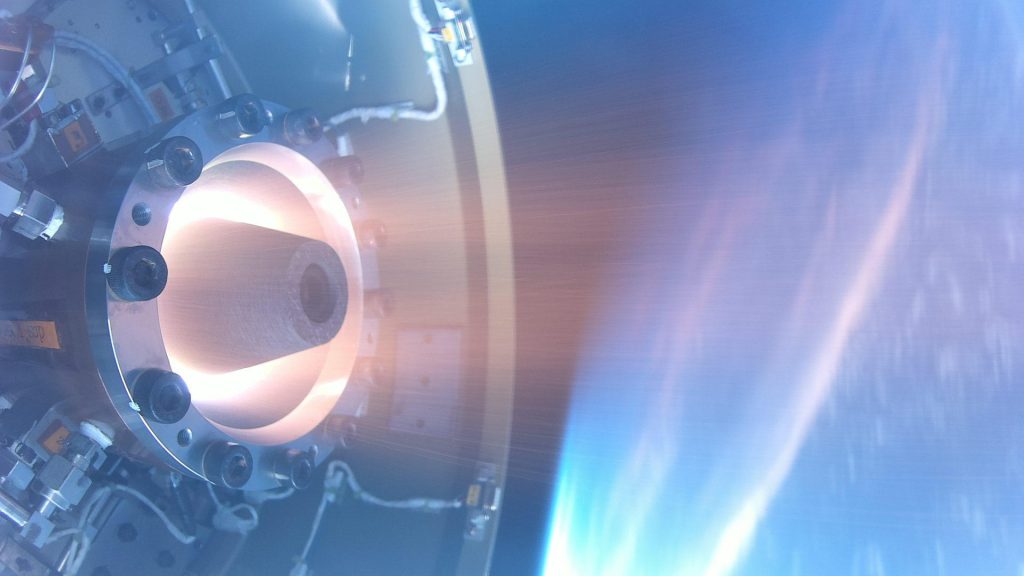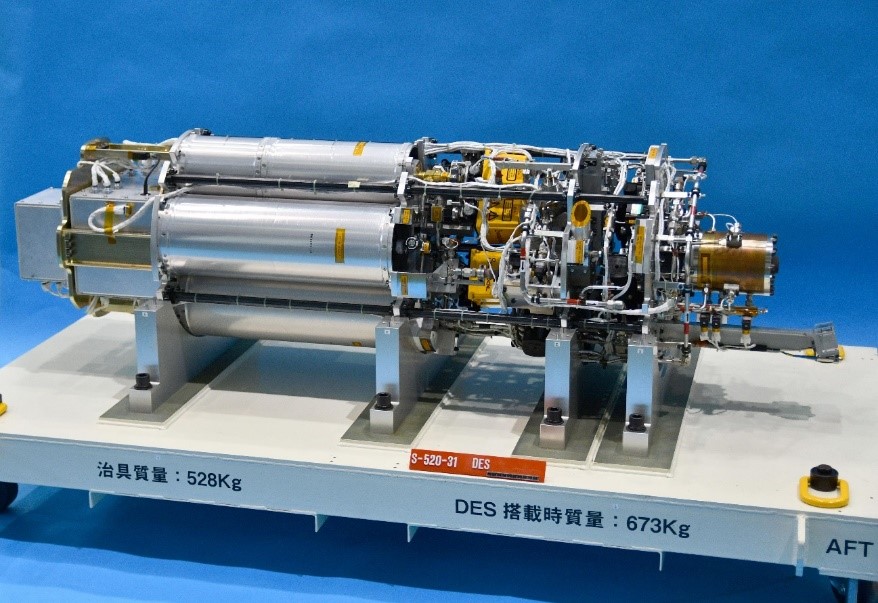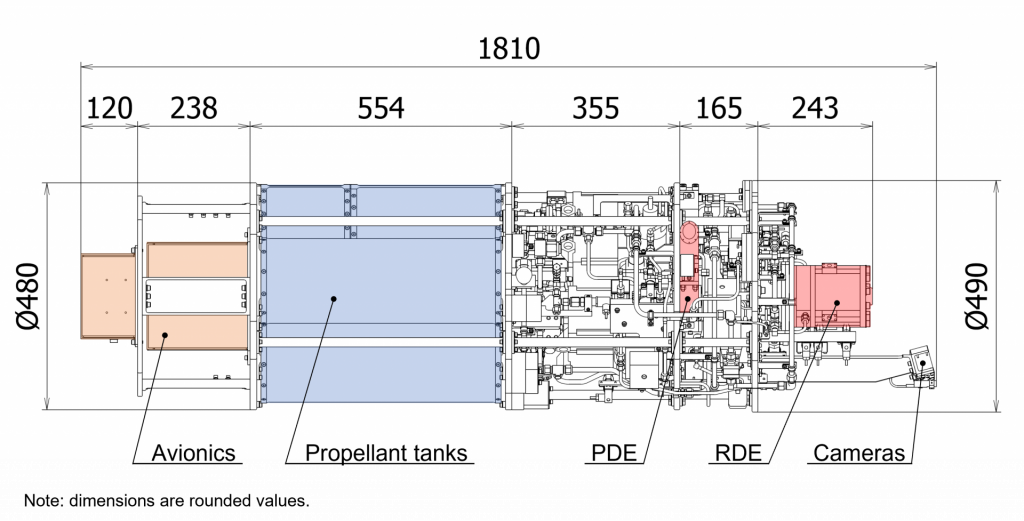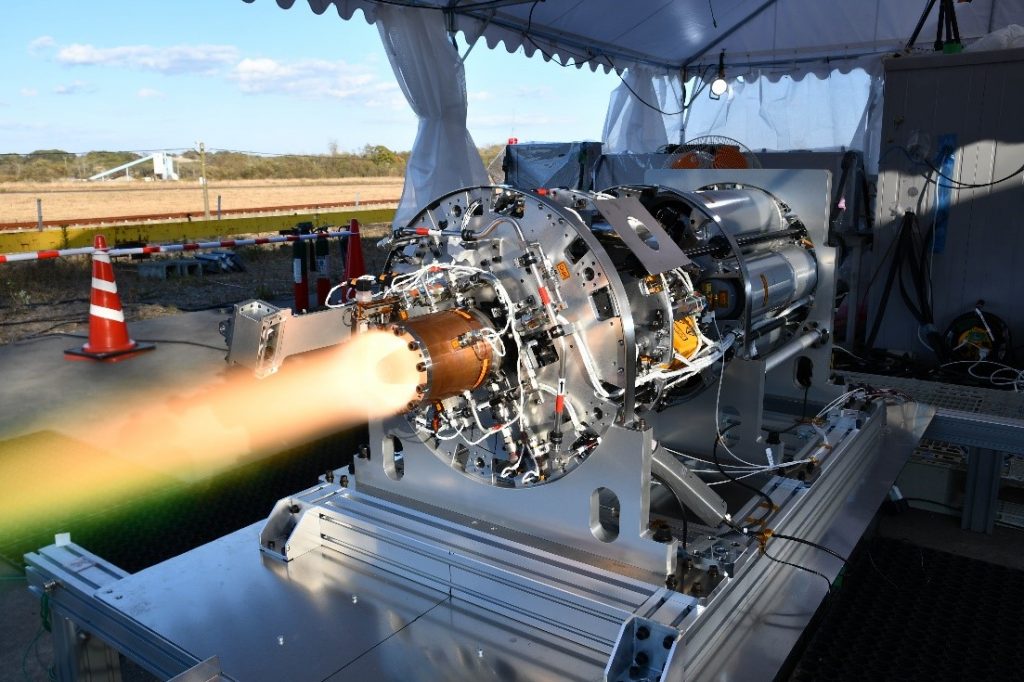A research group at the Institute of Materials and Systems for Sustainability, Nagoya University and the Graduate School of Engineering, Nagoya University, in collaboration with Keio University, Institute of Space and Astronautical Science (ISAS) of the Japan Aerospace Exploration Agency (JAXA), and the Muroran Institute of Technology, has successfully demonstrated a detonation engine in space flight. This is the world's first successful demonstration of a detonation engine in space flight.
The detonation engine system developed in this study was loaded onto the mission section of the sounding rocket S-520-31 and launched from the JAXA Uchinoura Space Center at 5:30 a.m. on July 27, 2021. After the separation of the first stage rocket, the rotating detonation engine and pulse detonation engine were successfully operated in space, and photo images, pressure, temperature, vibration, position, and attitude data were acquired by telemetry and RATS (Reentry and Recovery Module with Deployable Aeroshell Technology for Sounding Rocket Experiment). The fuel is methane and the oxidizer is oxygen.
The detonation engine generates detonation and compression waves at extremely high frequencies (1–100 kHz) to drastically increase reaction speed, leading to radical reduction of rocket engine weights and high performance by easy generation of thrust. The success of this space flight demonstration will bring the detonation engine much closer to practical use as a kick motor for deep space exploration, and as a first and second stage engine for rockets.
The results of this research will be published in academic journals after detailed analysis of the flight data. The development of the detonation engine system was carried out in cooperation with Nets Co., Ltd., and Meiji Electric Industries Co., Ltd.
This research was supported by the Strategic Development Research (Engineering) of the Advisory Committee for Space Engineering, Institute of Space and Astronautical Science, JAXA, from 2014–2021, the NEDO Feasibility Study Program on Energy and New Environmental Technology from 2014–2016, and the JSPS Grant-in-Aid for Specially Promoted Research from 2019–2023.
Major points
-
We present the world's first successful space flight demonstration of detonation engines.
-
The rotating detonation engine (RDE) and pulse detonation engine (PDE) were successfully operated in space under the flight environment, and the operating data of these engines were successfully acquired.
-
The results of this study show that the detonation engine is very close to practical use as an aerospace engine, such as a kick motor for deep space exploration.
Research background and content
The detonation engine generates detonation and compression waves at extremely high frequencies (1–100 kHz) to dramatically increase reaction speed, thereby enabling radical reduction of the weight of rocket engines and increasing their performance by enabling easy generation of thrust. At present, research is actively underway in Japan, North America, Europe, Asia, and Australia with a view to commercialization of a high-performance engine for space use.
This joint research group succeeded in achieving the world's first space flight demonstration of a detonation engine. The detonation engine system developed in this study was loaded onto the mission section of the sounding rocket S-520-31, and launched at 5:30 a.m. on July 27, 2021 from the JAXA Uchinoura Space Center (USC). After the separation of the first stage rocket, the RDE (6-sec operation, 500-N thrust) and PDE (2-sec operation x 3 times) operated normally in space, and images, pressure, temperature, vibration, position, and attitude data were acquired by telemetry and recovery module RATS. The fuel is methane and the oxidizer is oxygen.

Fig. 1 The moment the world's first rotating detonation engine (RDE) began operations in space. The elliptical luminous area (left) is the combustor of the double-cylinder rotating detonation engine. On the right is an image of the Earth taken from space. Image data was recovered by RATS. [Credit: Nagoya University, JAXA]

Fig. 2 Photograph of the Detonation Engine System (DES). [Credit: Nagoya University]

Fig. 3 Schematic diagram of the DES. From left to right: DES avionics (DES-PDU, DES-MCU, PI-BAT-L), methane, oxygen and nitrogen gas tanks (propellant tanks), gas supply system, PDE, RDE, DES cameras and Ku-TV antenna. [Credit: Nagoya University]

Fig. 4 Ground-based combustion test of the DES at the Shiraoi test site of Muroran Institute of Technology. [Credit: Nagoya University].
Significance of the results
The success of this space flight demonstration will bring the detonation engine much closer to practical use as a kick motor for deep space exploration, and as a first and second stage engine for rockets.
Existing rocket engines will be replaced by detonation engines, because detonation engines are lighter and have higher performance. In other words, the results of this research will be a catalyst for major changes in aerospace engines and systems.
Researcher Contact Information
Nagoya University
Institute of Materials and Systems for Sustainability
Jiro Kasahara, Professor
TEL: +81-52-789-4404
E-mail : kasahara@nuae.nagoya-u.ac.jp
Nagoya University team members researching detonation engine system (DES) part
Jiro Kasahara, Professor
Koichi Matsuyama, Designated Professor
Ken Matsuoka, Associate Professor
Akira Kawasaki, Assistant Professor
Hiroaki Watanabe, Assistant Professor
Noboru Itouyama, Designated Assistant Professor
Keisuke Goto, Designated Assistant Professor
Kazuki Ishihara, Graduate Student
Valentin Buyakofu, Graduate Student
Tomoyuki Noda, Graduate Student
Yuki Akimoto, Graduate Student
Koyo Kikuchi, Graduate Student
Related information
Article on ISAS/JAXA web site (in Japanese)
https://www.isas.jaxa.jp/topics/002693.html
Propulsion and Energy Systems Engineering Research Group, Nagoya University
http://www.prop.nuae.nagoya-u.ac.jp/index.html
Related published journal papers of this project
1. S. Sawada, K. Goto, K. Ishihara, A. Kawasaki, K. Matsuoka, J. Kasahara, A. Matsuo, I. Funaki, Experimental Study of Torque Around the Axial Direction on Rotating Detonation Engines, Journal of Propulsion and Power (accepted 2nd July, 2021)
2. K. Goto, Y. Kato, K. Ishihara, K. Matsuoka, J. Kasahara, A. Matsuo, I. Funaki, D. Nakata, K. Higashino, and N. Tanatsugu, Thrust Validation of Rotating Detonation Engine System by Moving Rocket Sled-Test, Journal of Propulsion and Power, Vol.37, No. 3, 2021, pp.419-425.
http://arc.aiaa.org/doi/abs/10.2514/1.B38037
3. K. Matsuoka, M. Tanaka, T. Noda, A. Kawasaki, J. Kasahara, Experimental Investigation on a Rotating Detonation Cycle with Burned Gas Backflow,Combustion and Flame, Vol.225, 2021, pp.13-19.
https://doi.org/10.1016/j.combustflame.2020.10.048
4. R. Yokoo, K. Goto, J. Kasahara, V. Athmanathan, J. Braun, G. Paniagua, T. Meyer, A. Kawasaki, K. Matsuoka, A. Matsuo, I. Funaki, Experimental Study of Internal Flow Structures in Cylindrical Rotating Detonation Engines, Proceedings of the Combustion Institute, Vol.38, No. 3, 2021, pp.3759-3768.
https://doi.org/10.1016/j.proci.2020.08.001
5. M. Yamaguchi, K. Matsuoka, A. Kawasaki, J. Kasahara, H. Watanabe, A. Matsuo, Investigation of combustion modes and pressure of reflective shuttling detonation combustor, Proceedings of the Combustion Institute, Vol.38, No. 3, 2021, pp.3615-3622.
https://doi.org/10.1016/j.proci.2020.07.064
6. R. Yokoo, K. Goto, J. Kim, A. Kawasaki, K. Matsuoka, J. Kasahara, A. Matsuo, I. Funaki, Propulsion Performance of Cylindrical Rotating Detonation Engine, AIAA Journal , Vol. 58, No. 12, 2020, pp.5107-5116.
http://arc.aiaa.org/doi/abs/10.2514/1.J058322
7. K. Matsuoka, H., Taki, A. Kawasaki, J. Kasahara, H. Watanabe, A. Matsuo, and T. Endo, Semi-Valveless Pulse Detonation Cycle at a Kilohertz-scale Operating Frequency, Combustion and Flame, Vol. 205, 2019, pp. 434-440.
https://doi.org/10.1016/j.combustflame.2019.04.035
8. J. Shepherd, J. Kasahara, Analytical Models for the Thrust of a Rotating Detonation Engine, GALCIT Report FM2017.001.
https://authors.library.caltech.edu/81786/1/rde_model_report.pdf
9. A. Kubota, K. Matsuoka, A. Kawasaki, J. Kasahara, H. Watanabe, A. Matsuo, and T. Endo, Optical Measurement of Fluid Motion in Semi-Valveless Pulse Detonation Combustor with High-Frequency Operation, Combustion Science and Technology, Vol. 192, 2020, pp.197-212. https://doi.org/10.1080/00102202.2018.1559837
10. K. Goto, J. Nishimura, A. Kawasaki, K. Matsuoka, J. Kasahara, A. Matsuo, I. Funaki, D. Nakata, M. Uchiumi, K. Higashino, Experimental Propulsive Performance and Heating Environment of Rotating Detonation Engine with Various Throat Geometries, Journal of Propulsion and Power, Vol. 35, No. 1, 2019, pp.213-223.
https://doi.org/10.2514/1.B37196
11. A. Kawasaki, T. Inakawa, J. Kasahara, K. Goto, K. Matsuoka, A. Matsuo, I. Funaki, Critical Condition of Inner Cylinder Radius for Sustaining Rotating Detonation Waves in Rotating Detonation Engine Thruster, Proceedings of the Combustion Institute, Vol. 37, No. 3, 2019, pp. 3461-3469.
https://doi.org/10.1016/j.proci.2018.07.070
12. M. Yamaguchi, K. Matsuoka, A. Kawasaki, J. Kasahara, H. Watanabe, A. Matsuo, Study on a Reflective Shuttling Detonation Wave in Fan-Shaped Two-Dimensional Combustor, Proceedings of the Combustion Institute, Vol. 37, No. 3, 2019, pp. 3741-3747.
https://doi.org/10.1016/j.proci.2018.06.210
13. K. Matsuoka, S. Takagi, J. Kasahara, A. Matsuo, T. Endo, Validation of Pulse Detonation Operation in Low-Ambient-Pressure Environment Journal of Propulsion and Power, Vol. 34, No. 1, 2018, pp.116-124.
https://doi.org/10.2514/1.B36401
14. S. Nakagami, K. Matsuoka, J. Kasahara, Y. Kumazawa, J. Fujii, A. Matsuo, I. Funaki, Experimental Visualization of the Structure of Rotating Detonation Waves in a Disk-Shaped Combustor, Journal of Propulsion and Power, Vol. 33, No. 1, 2017, pp.80-88.
https://doi.org/10.2514/1.B36084
15. K. Matsuoka, K. Muto, J. Kasahara, H. Watanabe, A. Matsuo and T. Endo, Development of High-Frequency Pulse Detonation Combustor without Purging Material, Journal of Propulsion and Power, Vol. 33, No. 1, 2017, pp.43-50.
https://doi.org/10.2514/1.B36068
16. S. Nakagami, K. Matsuoka, J. Kasahara, A. Matsuo, I. Funaki, Experimental Study of the Structure of Forward-Tilting Rotating Detonation Waves and Highly Maintained Combustion Chamber Pressure in a Disk-Shaped Combustor, Proceedings of the Combustion Institute, Vol. 36, No. 2, 2017, pp. 2673-2680.
https://doi.org/10.1016/j.proci.2016.07.097
17. K. Matsuoka, K. Muto, J. Kasahara, H. Watanabe, A. Matsuo, T. Endo, Investigation of Fluid Motion in Valveless Pulse Detonation Combustor with High-Frequency Operation, Proceedings of the Combustion Institute, Vol. 36, No. 2, 2017, pp. 2641-2647.
https://doi.org/10.1016/j.proci.2016.07.069
18. K. Matsuoka, T. Morozumi, S. Takagi, J. Kasahara, A. Matsuo, I. Funaki, Flight Validation of a Rotary-Valved Four-Cylinder Pulse Detonation Rocket, Journal of Propulsion and Power, Vol. 32, No. 2, 2016, pp.383-391.
https://doi.org/10.2514/1.B35739
19. K. Matsuoka, R. Sakamoto, T. Morozumi, J. Kasahara, A. Matsuo, I. Funaki, Thrust Performance of Rotary-Valved Four-Cylinder Pulse Detonation Rocket Engine, Transaction of the Japan Society for Aeronautical and Space Sciences, Vol. 58, No. 4, pp. 193-203, 2015.
https://doi.org/10.2322/tjsass.58.193
20. H. Nakayama, J. Kasahara, A. Matsuo, and I. Funaki, Front shock behavior of stable curved detonation waves in rectangular-cross-section curved channels, Proceedings of the Combustion Institute, Vol. 34, 2013, pp.1939-1947.
https://doi.org/10.1016/j.proci.2012.06.012
21. H. Nakayama, T. Moriya, J. Kasahara, A. Matsuo, Y. Sasamoto, and I. Funaki, Propagation of Curved Detonation Waves Stabilized in Annular Channels, Transaction of JSASS Aerospace Technology Japan, 10, ists28, Pe_7-14 (2012).
https://doi.org/10.2322/tastj.10.Pe_7
22. K. Matsuoka, M. Esumi, K. B. Ikeguchi, J. Kasahara, A. Matsuo, and I. Funaki, Experimental Investigation of a Multi-Cycle Single Tube Pulse Detonation Rocket Engine with a Coaxial Rotary Valve, Transaction of JSASS Aerospace Technology Japan, 10, ists28, Te_1-4 (2012).
https://doi.org/10.2322/tastj.10.Te_1
23. K. Matsuoka, M. Esumi, K. B. Ikeguchi, J. Kasahara, A. Matsuo, and I. Funaki, Optical and Thrust Measurement of a Pulse Detonation Combustor with a Coaxial Rotary Valve, Combustion and Flame, Vol. 159, 2012, No. 3, pp.1321-1338.
https://doi.org/10.1016/j.combustflame.2011.10.001
24. H. Nakayama, T. Moriya, J. Kasahara, A. Matsuo, Y. Sasamoto, and I. Funaki, Stable Detonation Wave Propagation in Rectangular-Cross-Section Curved Channels, Combustion and Flame, Vol. 159, 2012, No. 2, pp.859-869.
https://doi.org/10.1016/j.combustflame.2011.07.022
25. K. Kawane, S. Shimada, J. Kasahara, and A. Matsuo, The Influence of Heat Transfer and Friction on the Impulse of a Detonation Tube, Combustion and Flame , Vol. 158, No. 10, 2011, pp.2023-2036.
https://doi.org/10.1016/j.combustflame.2011.02.017
26. K. Matsuoka, J. Yageta, T. Nakamichi, J. Kasahara, T. Yajima, T. Kojima, Inflow-Driven Valve System for Pulse Detonation Engines, Journal of Propulsion and Power, Vol. 27, No.3, May-June 2011, pp.597-607.
https://doi.org/10.2514/1.47421
27. J. Kasahara, M. Hirano, A. Matsuo, Y. Daimon, T. Endo, Thrust Measurement of a Multicycle Partially Filled Pulse Detonation Rocket Engine, Journal of Propulsion and Power, Vol.25, No.6, November-December 2009, pp.1281-1290.
https://doi.org/10.2514/1.42224
28. J. Kasahara, A. Hasegawa, T. Nemoto, H. Yamaguchi,T. Yajima , T. Kojima, Performance Validation of a Single-Tube Pulse Detonation Rocket System, Journal of Propulsion and Power, Vol.25, No.1, January-February 2009, pp.173-180.
https://doi.org/10.2514/1.37924
29. J. Kasahara, Z. Liang, S. T. Browne, and J. E. Shepherd, Impulse Generation by an Open Shock Tube, AIAA Journal, Vol.46, No. 7, 2008, pp.1593-1603.
https://doi.org/10.2514/1.27467
名古屋大学のプレスリリース
詳細PDFはこちらから>>> (Only in Japanese)


